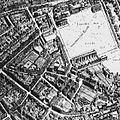
Sardinia Street, formerly Duke Street, was the northern continuation of Kemble Street (formerly Princes Street). It ended, like its successor, on the west side (carriageway) of Lincoln's Inn Fields in the north, but further north. It was joined on its western side by King's Head Yard (demolished) and Wild Street (formerly Great Wild Street), and opposite by Vere Street (demolished). On the eastern side at the northern end was a Roman Catholic chapel and chapel yard.



